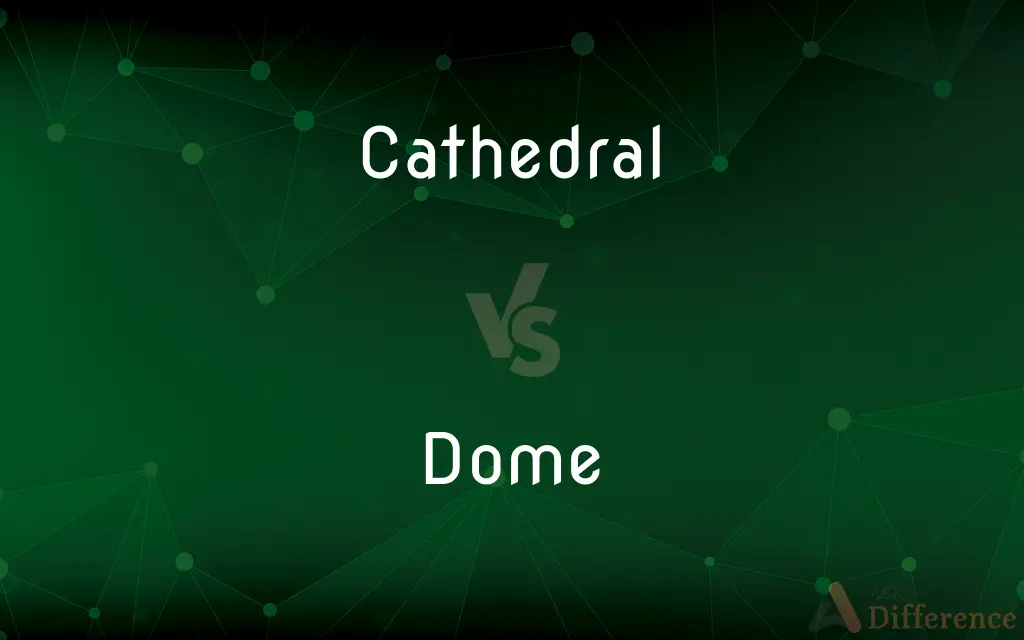Cathedral vs. Dome — What's the Difference?
By Urooj Arif & Maham Liaqat — Updated on March 28, 2024
A cathedral is a large, important church that serves as a central place for worship, often with a bishop, while a dome is an architectural element featuring a rounded vault forming the roof of a building or structure.

Difference Between Cathedral and Dome
Table of Contents
ADVERTISEMENT
Key Differences
A cathedral, in its most fundamental aspect, serves as the principal church within a diocese, embodying the focal point of Christian worship and episcopal authority. It is often characterized by its grandiose architecture, including spires, towers, and sometimes, intricate facades. On the other hand, a dome is an architectural feature that spans over a circular, square, or polygonal space, providing a roof or a significant part of the roof in a building. Domes are valued for their aesthetic and structural qualities, appearing in various religious and secular buildings worldwide.
While cathedrals are specific to Christian denominations and symbolize ecclesiastical power and community, domes have been used in the architecture of many cultures and religions. Domes can be found atop buildings ranging from ancient Roman temples to modern-day governmental edifices, serving both as decorative elements and as engineering solutions to covering large spaces. In contrast, the construction of a cathedral is often intended to inspire awe and reverence, with its design reflecting theological concepts and the church's societal status.
Cathedrals often contain domes as part of their architectural design, integrating these rounded vaults to create visually stunning interiors and to signify heavenly symbolism. Conversely, domes are not limited to religious structures and can be featured in secular buildings such as capitol buildings, sports stadiums, and museums. This distinction highlights the dome's versatility as an architectural element versus the cathedral's specific religious function.
The design and construction of cathedrals are guided by the principles and needs of the religious institution they serve, often incorporating elements like nave, choir, and transept, which are significant for liturgical practices. Domes, however, are defined by their geometric and structural characteristics, requiring engineering ingenuity to span large areas without internal supports, thus showcasing advances in architectural technology.
Cathedrals are historically significant, often serving as landmarks that chronicle the cultural and religious history of a location. They are destinations for pilgrimages, reflecting the spiritual and social life of the community. Domes, while they can also be emblematic and culturally significant, are appreciated for their contribution to the skyline and the engineering marvels they represent, transcending their utilitarian function to become symbols of human achievement and creativity.
ADVERTISEMENT
Comparison Chart
Definition
A principal church of a diocese, often containing the bishop's seat.
A rounded vault forming the roof of a building or structure.
Primary Function
Place of worship and religious governance.
Architectural element providing a roof or part of a roof.
Cultural Significance
Symbolizes ecclesiastical authority and community.
Represents architectural innovation and aesthetic appeal.
Usage
Exclusive to Christian worship and ceremonies.
Used in various religious and secular buildings across cultures.
Architectural Features
May include towers, spires, and stained glass windows.
Characterized by its shape, which can be hemispherical, onion-shaped, etc.
Compare with Definitions
Cathedral
Many cathedrals are historical landmarks with significant cultural value.
This cathedral, built in the 12th century, has been a witness to the city's history.
Dome
A dome is an architectural element that resembles the upper half of a sphere.
The Pantheon in Rome is famous for its ancient Roman dome.
Cathedral
A cathedral is the main church of a diocese, containing the bishop's throne.
The Notre-Dame de Paris is a famous cathedral known for its French Gothic architecture.
Dome
Domes can be made from various materials, including concrete, metal, and glass.
The museum's glass dome floods the interior with natural light.
Cathedral
Cathedrals may incorporate various styles, including Gothic, Romanesque, and Baroque.
The cathedral's Gothic spires are visible from miles around the city.
Dome
Many religious buildings feature domes as symbols of the heavens.
The mosque's dome is adorned with intricate Islamic calligraphy.
Cathedral
Cathedrals often serve as centers of worship and community gatherings.
The cathedral hosts annual Christmas and Easter services that attract thousands.
Dome
The engineering of domes has evolved to include modern materials and techniques.
The dome's lightweight structure is made possible by advanced engineering materials.
Cathedral
Architecturally, cathedrals are noted for their grandeur and size.
The cathedral's imposing structure features a high nave supported by flying buttresses.
Dome
Domes are used to cover large spaces without internal supports.
The stadium's dome allows it to host events in all weather conditions.
Cathedral
A cathedral is a church that contains the cathedra (Latin for 'seat') of a bishop, thus serving as the central church of a diocese, conference, or episcopate. Churches with the function of "cathedral" are usually specific to those Christian denominations with an episcopal hierarchy, such as the Catholic, Anglican, Eastern Orthodox, and some Lutheran churches.
Dome
A dome (from Latin: domus) is an architectural element similar to the hollow upper half of a sphere; there is significant overlap with the term cupola, which may also refer to a dome or a structure on top of a dome. The precise definition of a dome has been a matter of controversy and there are a wide variety of forms and specialized terms to describe them.
Cathedral
The principal church of a bishop's diocese, containing the episcopal throne.
Dome
A roof or vault having a circular, polygonal, or elliptical base and a generally hemispherical or semispherical shape.
Cathedral
A large, important church.
Dome
A geodesic dome.
Cathedral
Something that resembles a cathedral, as in grandeur or authority.
Dome
A domelike structure or object.
Cathedral
Of, relating to, or containing a bishop's throne
A cathedral church.
Dome
A system of strata that is uplifted in the center, forming a concentric anticline.
Cathedral
Relating to or issuing from a chair of office or authority; authoritative.
Dome
A mass of granite that has been weathered into a rounded shape by exfoliation.
Cathedral
Of, relating to, or resembling a cathedral
Tall trees whose branches met to form cathedral arches over the path.
Dome
A mound formed by the extrusion of viscous lava from a volcano.
Cathedral
Relating to the throne or the see of a bishop.
Dome
(Chemistry) A form of crystal with two similarly inclined faces that meet at an edge parallel to the horizontal axis.
Cathedral
The principal church of an archbishop's/bishop's archdiocese/diocese which contains an episcopal throne.
Dome
(Slang) The human head.
Cathedral
(loosely or informally) A large or important church building.
Dome
(Archaic) A large, stately building.
Cathedral
(figurative) A large, impressive, lofty, and/or important building or place of some other kind.
Dome
To cover with or as if with a dome.
Cathedral
A large buttressed structure built by certain termites.
Dome
To shape like a dome.
Cathedral
In certain right-wing conspiracy theories, the mainstream system or establishment of society, held to be liberal or leftist and to be working against the interests of the people or nation, which is both.
Dome
To rise or swell into the shape of a dome.
Cathedral
The principal church in a diocese, so called because in it the bishop has his official chair (Cathedra) or throne.
Dome
(architecture) A structural element resembling the hollow upper half of a sphere.
Geodesic dome
Cathedral
Pertaining to the head church of a diocese; as, a cathedral church; cathedral service.
Dome
(by extension) Anything shaped like an upset bowl, often used as a cover.
A cake dome
Lava dome
Cathedral
Emanating from the chair of office, as of a pope or bishop; official; authoritative.
Now, what solemnity can be more required for the pope to make a cathedral determination of an article!
Dome
(informal) A person's head.
Cathedral
Resembling the aisles of a cathedral; as, cathedral walks.
Dome
A building; a house; an edifice.
Pleasure dome
Cathedral
Any large and important church
Dome
(by extension) Any erection resembling the dome or cupola of a building, such as the upper part of a furnace, the vertical steam chamber on the top of a boiler, etc.
Steam dome
Cathedral
The principal Christian church building of a bishop's diocese
Dome
(crystallography) A prism formed by planes parallel to a lateral axis which meet above in a horizontal edge, like the roof of a house; also, one of the planes of such a form.
Cathedral
Relating to or containing or issuing from a bishop's office or throne;
A cathedral church
Dome
(geology) A geological feature consisting of symmetrical anticlines that intersect where each one reaches its apex.
Dome
(transitive) To give a domed shape to.
Dome
To shoot in the head.
That guy just got domed!
Dome
To perform fellatio on.
Dome
A building; a house; an edifice; - used chiefly in poetry.
Approach the dome, the social banquet share.
Dome
A cupola formed on a large scale.
Dome
Any erection resembling the dome or cupola of a building; as the upper part of a furnace, the vertical steam chamber on the top of a boiler, etc.
Dome
A prism formed by planes parallel to a lateral axis which meet above in a horizontal edge, like the roof of a house; also, one of the planes of such a form.
Dome
Decision; judgment; opinion; a court decision.
Dome
A concave shape whose distinguishing characteristic is that the concavity faces downward
Dome
Informal terms for a human head
Dome
A stadium that has a roof
Dome
A hemispherical roof
Common Curiosities
What is the primary purpose of a cathedral?
A cathedral serves as the principal church in a diocese, central to worship and religious governance.
What distinguishes a dome from other architectural elements?
A dome is specifically a rounded vault that forms or covers part of a roof, notable for its aesthetic and structural qualities.
How do cathedrals reflect cultural history?
Cathedrals often embody architectural styles, religious practices, and societal changes of their time, serving as historical landmarks.
Can the design of a dome vary?
Yes, domes come in various shapes including hemispherical, onion-shaped, and elliptical, depending on the architectural requirements and style.
Why are domes used in building design?
Domes are used for their ability to cover large spaces efficiently and for their aesthetic appeal.
What role do cathedrals play in a community?
Cathedrals serve as places of worship, community gathering spots, and symbols of faith and tradition.
Can a dome be part of a cathedral?
Yes, many cathedrals incorporate domes into their architecture for aesthetic and symbolic reasons.
Are all domes associated with religious buildings?
No, while many domes are found on religious structures, they are also used in secular buildings for their engineering and design merits.
What architectural styles are common in cathedrals?
Gothic, Romanesque, Baroque, and Renaissance are among the common styles for cathedrals.
How has the construction of domes evolved over time?
Dome construction has evolved with advances in materials and engineering, allowing for larger and more complex designs.
Do all cathedrals have domes?
Not all cathedrals have domes; the presence of a dome depends on the architectural style and design of the cathedral.
Is there a difference in the materials used for cathedrals and domes?
The materials can vary widely depending on the period and style; cathedrals may use stone or brick, while domes can be constructed from concrete, metal, or glass.
Share Your Discovery

Previous Comparison
Nodachi vs. Katana
Next Comparison
Gone vs. LostAuthor Spotlight
Written by
Urooj ArifUrooj is a skilled content writer at Ask Difference, known for her exceptional ability to simplify complex topics into engaging and informative content. With a passion for research and a flair for clear, concise writing, she consistently delivers articles that resonate with our diverse audience.
Co-written by
Maham Liaqat














































